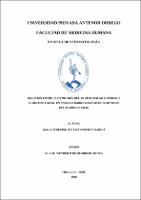Mostrar el registro sencillo del ítem
Relación entre la extrusión del primer molar superior y el biotipo facial en análisis radiográficos de sujetos de 18 a 30 años de edad
| dc.contributor.advisor | Portocarrero Reyes, Weyder | |
| dc.contributor.author | Sánchez García, Katherine Melissa | |
| dc.creator | Sánchez García, Katherine Melissa | |
| dc.date.accessioned | 2018-05-09T23:02:09Z | |
| dc.date.available | 2018-05-09T23:02:09Z | |
| dc.date.issued | 2018 | |
| dc.identifier.uri | https://hdl.handle.net/20.500.12759/4099 | |
| dc.description.abstract | El presente estudio tuvo como objetivo determinar si existe relación entre la extrusión del primer molar superior y el biotipo facial en sujetos de 18 a 30 años de edad. El estudio retrospectivo, transversal, descriptivo y observacional. El trabajo se realizó en un centro radiológico de Trujillo e incluyó un total de 140 radiografías de sujetos entre 18 y 30 años de edad. Para evaluar la extrusión del primera molar superior se trazó una línea perpendicular al plano palatino que se extiende desde el plano palatino hasta la punta de la cúspide mesial del primer molar superior y el biotipo facial se evaluó a través del plano mandibular (línea Go-Me a SN) clasificándose a los pacientes en caras largas (>35°), caras promedio (30°-35°) o caras cortas (< 30°). Para el análisis estadístico de la relación entre la extrusión del primer molar superior y el biotipo facial en análisis radiográficos de sujetos de 18 a 30 años se empleó el coeficiente de correlación de Spearman, estimación puntual e interválica. Se consideró agrupación según sexo y edad. Se consideró un nivel de significancia del 5%. Como resultado obtuvimos una significancia de P > 0.05 entre la relación de la extrusión del primer molar superior y el biotipo facial, concluyendo que no existe relación alguna entre la extrusión del primer molar superior y el biotipo facial. | es_PE |
| dc.description.abstract | This thesis aims to determine whether there is a relationship between the extrusion of the first upper molar and the facial biotype in subjects between 18 and 30 years olds. The study is retrospective, cross-sectional, descriptive and observational. It was carried out in a radiological center in Trujillo and included 140 radiographs of subjects between 18 and 30 years old. In order to measure the extrusion of the first maxillary molar, a perpendicular line to the palatal plane was drawn that extends from the palatal plane to the tip of the mesial cusp of the upper first molar and to measure the facial biotype, it was used the mandibular plane (Go-Me-Sn line). Patients were classified into long faces (> 35 °), average faces (30 ° -35 °) or short faces (<29 °). For the statistical analysis of the relationship between the extrusion of the first upper molar and the facial biotype in radiographic analyzes of subjects aged 18 to 30 years old, I used Spearman ratio coefficient, point and interval estimation. Also I consider to groups according to sex and age and a level of significance of 5%. I found that there is not a significant difference (P> 0.05) between the relation of the extrusion of the first upper molar and the facial biotype in subjects from 18 to 30 years old, so there is no relationship between these two variables. | en_US |
| dc.description.uri | Tesis | es_PE |
| dc.format | application/pdf | es_PE |
| dc.language.iso | spa | es_PE |
| dc.publisher | Universidad Privada Antenor Orrego - UPAO | es_PE |
| dc.relation.ispartofseries | T_ESTO_507 | |
| dc.rights | info:eu-repo/semantics/openAccess | es_PE |
| dc.source | Universidad Privada Antenor Orrego | es_PE |
| dc.source | Repositorio institucional - UPAO | es_PE |
| dc.subject | Extrusión | es_PE |
| dc.subject | Biotipo Facial | es_PE |
| dc.title | Relación entre la extrusión del primer molar superior y el biotipo facial en análisis radiográficos de sujetos de 18 a 30 años de edad | es_PE |
| dc.type | info:eu-repo/semantics/bachelorThesis | es_PE |
| thesis.degree.level | Título Profesional | es_PE |
| thesis.degree.grantor | Universidad Privada Antenor Orrego. Facultad de Medicina Humana | es_PE |
| thesis.degree.name | Cirujano Dentista | es_PE |
| thesis.degree.discipline | Estomatología | es_PE |
Ficheros en el ítem
Este ítem aparece en la(s) siguiente(s) colección(es)
-
Estomatología [567]

